Kids develop hand skills through play as they discover what they can do with their hands in their environment. Hand dominance occurs naturally through this discovery and play. You may have heard the terms Cross–dominance or hand confusion in a therapy report. This mixed dominance may present in a child’s motor actions when they favors one hand for some tasks and the other hand for others. Hand dominance activities and establishment of a preferred hand in activities refines motor skills and allows for more skilled movements.
Hand dominance
But what happens when those two-handed activities do not transition to preferred use of one hand over the other? At a certain point, kids begin to show hand dominance in functional tasks as their motor skills develop.
A child begins to show laterality of their hands in functional tasks as one side of their brain gains dominance and allows the child to prefer use of one hand over the other.
Other kids show a mixed dominance and use both of their hands in activities. Wondering where to begin or how to know what is typical in development? Read on for hand dominance activities that will help!
What is laterality
Laterality and left right discrimination are closely related.
Laterality is a preference, or a dominance for one side of the body over the other. This is shown with a stronger arm, more precision in one hand over the other, or a more dominant eye in visual tasks and a more dominant foot or stronger leg in balance and kicking tasks. Laterality is shown in then hands with handwriting, scissor tasks, knife and fork tasks, etc. Laterality is a brain skill. It’s a preference of one side of the brain in controlling the arm/leg/eye which is stronger on one side of the body over the other in activities or functional tasks.
Lateralization refers to the brain’s ability to control the two sides of the body. Each hemisphere of the brain controls different tasks and functions. When a child shows difficulties with laterality, they might switch objects between the two hands in functional tasks. As a child grows, they are challenged to become more efficient with tools in school.
What is left right discrimination
Left/right discrimination “on the other hand” is a complex neuropsychologic process that calls upon several higher functions, including visuospatial processing, memory, language and integration of sensory information to allow identification of one side of the body as distinct from the other, no matter the direction the body is facing. Many kids have trouble knowing which hand is their left or right. They might switch hands in tasks, or have difficulty with following spatial relation directions… Sound familiar?
Left Right Discrimination is a skill that impacts spatial awareness and spatial concepts in functional tasks such as dressing, handwriting, using a knife and fork, scissors/paper, and other tasks that require a dominant hand or direction-following. Difficulties with left/right discrimination display themselves during holding a pencil, writing, forming letters, copying words, math, auditory directions, safety, direction-following, games like baseball, Simon Says, hokey pokey, etc.
More information on these concepts and activities to improve directionality are in these blog posts:
- Ambidexterity or mixed dominance, which one? This blog post helps to explain what you are seeing when kids mix their hands in activities.
- What are visual spatial relations? This is a good starting point to work on the spatial concepts and integrating left/right in activities.
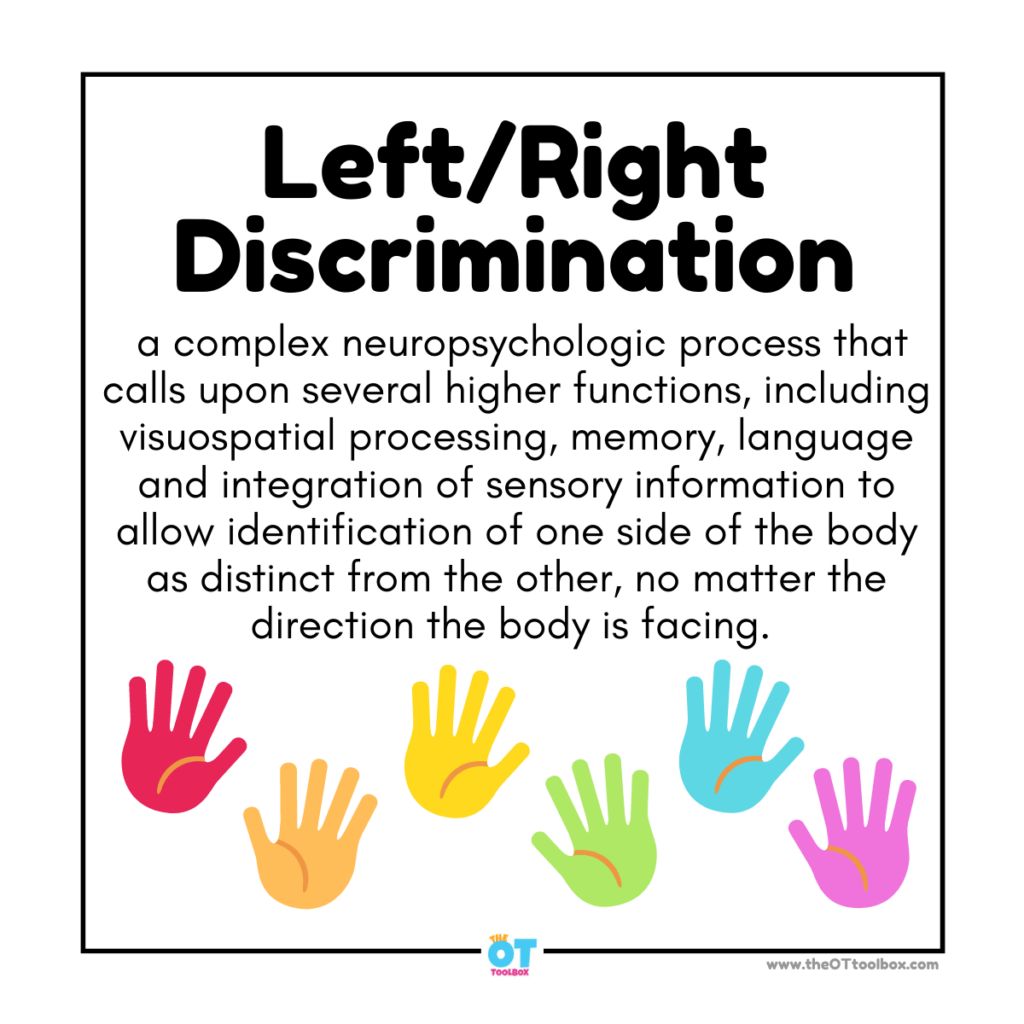
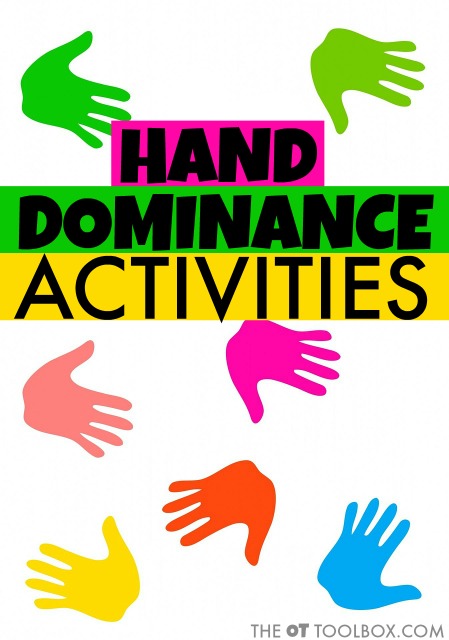
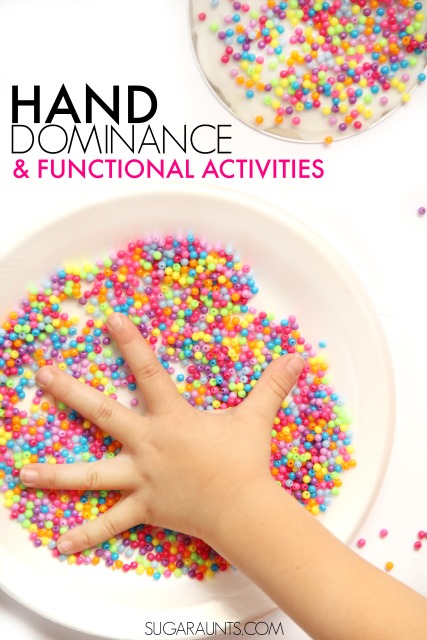
Development of Hand Dominance
Kids switching hands in an activity? Maybe you are seeing a child use one hand for some activities and their other hand for other activities. Still other children may use both hands interchangeably. Development of hand dominance can be established at different rates.
True hand dominance can develop as late as 8 or 9 years of age, but typically children begin to demonstrate preferred use of one hand over the other at 2.5 to 3 years.
Sometimes, however, kids switch hands. They might use one hand for some tasks, and the other for other tasks. They might equally use hands in activities like handwriting, scissor skills, brushing teeth, or swinging a bat.
Why does this mixed dominance occur and why is it important for kids to establish a preferred hand?

Why is hand dominance important?
Hand preference has been associated with various difficulties. When using an established hand in activities is a problem (or kids swap hands), there can be other issues occurring. These may include trouble with bilateral coordination, using both hands together at the midline, and crossing midline.
Other concerns related to using both hands interchangeably can include:
Fine Motor Skills- Think about it this way: when a child cuts with scissors, they use one hand to hold the paper and the other hand to manipulate and move the scissors. As they develop in this skill, they are able to cut paper and shapes with more precision. They can cut progressively more detailed and more complex shapes. The child that switches hands when cutting with scissors may struggle to progress with refine and precise motor actions.
Similarly, the nondominant hand becomes more reliable in its ability to be a stable and sturdy assist in tasks like cutting with scissors, holding a ruler, or writing with a pencil.
Mixed handedness can impact handwriting too. In the same manner, any functional task can be impacted by mixed dominance.
3 Quick Hand Dominance activities
These are easy hand dominance activities and easy ways to work on a hand preference in kids who switch hands during tool use. They might have trouble identifying left or right on themselves, which makes direction following difficult. Try these activities to work on hand dominance:
1. Play the “Show Me” game– Ask the child to “show me how you brush your hair.” The child can demonstrate with an imaginary brush how they would brush their hair. By using imaginary brush, the child does not have to worry about picking up the tool. They will automatically brush without thinking about it. As the child pretends to brush their hair, the adult can point out which hand they are using. Putting a name to the hand alerts the child to which hand they are using. You can then use this information to help the child remember which hand they use in functional tasks. (“Hold the pencil with the hand you brush your hair with.”)
Continue this hand dominance game with other “Show Me” tasks:
- Show me how you brush your teeth.
- Show me how you hold a pencil.
- Show me how you paint a picture.
- Show me how you hold scissors.
2. Play Simon Says– Encourage a lot of handedness activities during the game:
- Simon Says put your right hand in your pocket.
- Simon Says scratch your leg with your left hand.
- Simon Says stomp your right leg.
- Simon Says take two steps to the left.
When playing, you can add a rubber band to the child’s right hand. Tell them and show them that the rubber band is on their RIGHT hand. After playing with successful lateralization, remove the rubber band.
3. Using masking tape, create floor maps. Make a large square shape on the floor and as the child walks through the maze, have the child stop at the corners and tell you if they have to turn right or left.
Continue this activity with movement tasks that ingrain the motor planning. As you say left, stomp the left foot. When you say right stomp the right foot. Model this task by standing in front of and slightly to the side of the child (not facing the child, as this can cause confusion). Stomping and marching games are helpful to integrate the motor planning and muscle memory of knowing left and right. Continue this activity over the course of days and weeks.
Continue practicing these games and activities with less verbal and visual prompts. Let me know if you try these ideas at home.
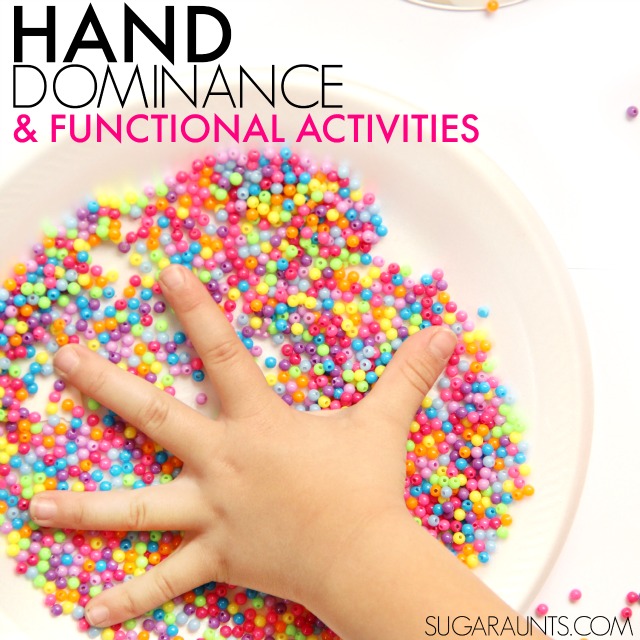
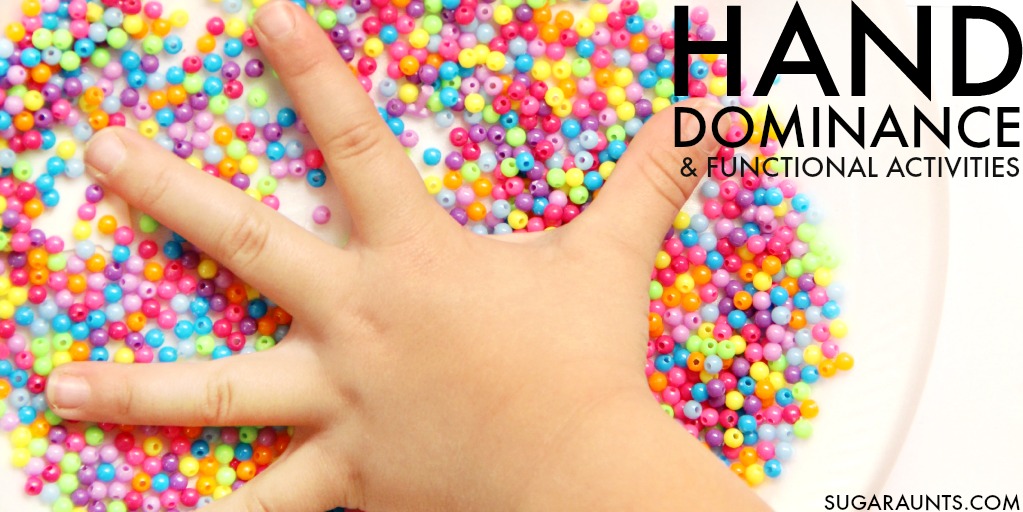
More ways to practice hand dominance with kids:
Tools in Fine Motor Development






